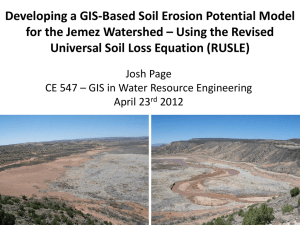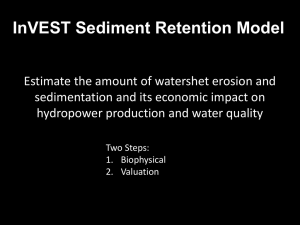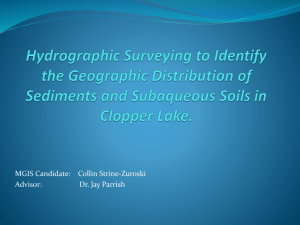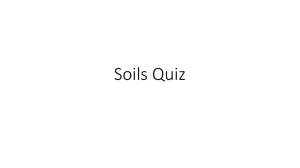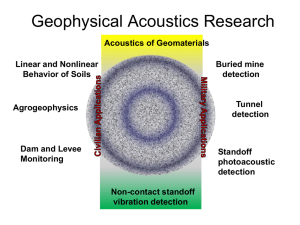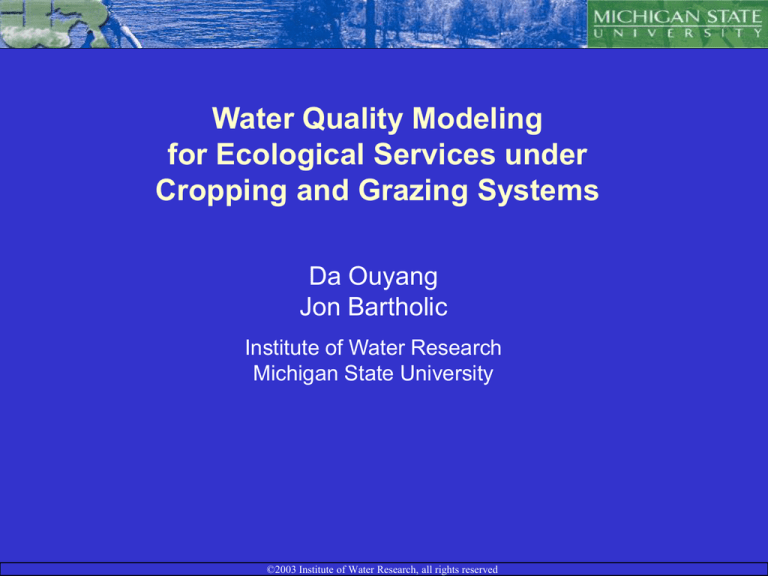
Water Quality Modeling
for Ecological Services under
Cropping and Grazing Systems
Da Ouyang
Jon Bartholic
Institute of Water Research
Michigan State University
©2003 Institute of Water Research, all rights reserved
Water Quality Modeling
Surface Water Quality
- Soil Erosion
- Sediment Delivery
- Nutrient Loading (P, N)
Groundwater Quality
- Pesticide / Nutrient Leaching
©2003 Institute of Water Research, all rights reserved
Water Quality Modeling
Surface Water Quality Modeling
- RUSLE
- SEDMOD
- AGNPS / SWAT
- MARI & Nutrient Loading Coefficients
Groundwater Quality Modeling
- WIN-PST (Pesticide Screening Tool)
©2003 Institute of Water Research, all rights reserved
RUSLE
Revised Universal Soil Loss Equation
©2003 Institute of Water Research, all rights reserved
RUSLE
A = R K LS C P
A = Soil loss in tons per acre per year
R = Rainfall-runoff erosivity factor
K = Soil erodibility factor
S = Slop steepness factor
L = Slope length factor
C = Cover-management factor
P = Support practice factor
©2003 Institute of Water Research, all rights reserved
SEDMOD
Spatially Explicit Sediment Delivery Model
©2003 Institute of Water Research, all rights reserved
Spatially Explicit Sediment Delivery Model (SEDMOD)
SDR = 39 A –1/8 + DP
Where SDR = sediment delivery ratio
A
= watershed area in square km
DP = difference between the composite delivery
potential and its mean value
©2003 Institute of Water Research, all rights reserved
SEDMOD
Delivery Potential composite layer in GRID
DP = (SG)r(SG)w + (SS)r(SS)w + (SR)r(SR)w +
(SP)r(SP)w + (ST)r(ST)w + (OF)r(OF)w
Where SG = slope gradient
SS = slope shape
SR = surface roughness
SP = stream proximity
ST = soil texture
OF = overland flow index
r = parameter rating (1-100)
w = weighting factor (0-1)
©2003 Institute of Water Research, all rights reserved
Sediment Yield
SY = A * SDR
Where SY = Sediment Yield
A = Gross Soil Loss
SDR = Sediment Delivery Ratio
©2003 Institute of Water Research, all rights reserved
WIN-PST
Window-Based Pesticide Screening Tool
©2003 Institute of Water Research, all rights reserved
WIN-PST
(Window-Based Pesticide Screening Tool)
Assess relative likelihood of pesticide loss from
- field boundaries via runoff
- below the root zone via percolation
Overall risk ratings are based on a matrix of
- Pesticide (toxicity, application method and rate)
- Soil (Soil texture, hydrologic group, slope, water table)
©2003 Institute of Water Research, all rights reserved
MARI
Manure Application Risk Index
©2003 Institute of Water Research, all rights reserved
MARI
(Manure Application Risk Index)
Identify areas where winter-time spreading of manure
may cause potential risk for runoff losses of N or P
12 Field parameters:
Soils; Slope; Soil Test P;
Concentration Water Flow; Residue/Cover;
Surface Water Setback; Vegetative Buffer Width;
Manure P / N Application Rate; Manure Application Method;
Others.
©2003 Institute of Water Research, all rights reserved
Data
•
•
•
•
•
DEM (Digital Elevation Model, 30-meter)
SSURGO Soil Data (Soil Survey Geographic Database)
Landuse / Land cover data
Crop Residue Management Data (CTIC)
Other
- EPA BASINS
©2003 Institute of Water Research, all rights reserved
Data and Tools for Water Quality Modeling
Previous Studies
Stony Creek Study
Estimated soil loss, sediment and phosphorus in
Stony Creek Watershed (tons / year)
Erosion
Sediment
Phosphorus
Corn-Corn
Corn-Soybean
Soybean-Wheat
182,000
154,000
67,000
61,000
52,000
28,000
129
112
59
Measured Phosphorus and Suspended Solids
In Sycamore Creek Watershed, MI
30
y = 2.1343x
R2 = 0.9943
Total Phosphorus (kg)
25
20
15
10
5
0
0
5
10
Suspended Solids (ton)
15
Findings from other study
(Randall et al. 1997)
NO3 – losses from row crops (corn, soybean)
were 30-50 times greater than losses from
perennial crops such as Alfalfa
Atrazine Leaching Risk Mapping
Great Lakes Basin
Estimated Potential Sediment Loading
Contributed from Cropland (tons/yr.)
©2003 Institute of Water Research, all rights reserved
Questions & Discussion
(C = Cover-management factor)



